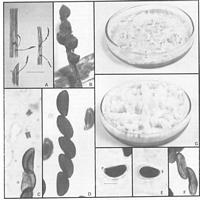|
 Xylaria sp. 2 Xylaria sp. 2
BiostatusPresent in region - Indigenous
Images (click to enlarge)
Caption: Fig. 18 Xylaria taxonomic species 2 A, Stromata. B, Stromal surface. C, Ascal ring
(Melzer's reagent). D, Ascospores in an ascus (Melzer's reagent). E, Two ascospores with
a basal appendage (Melzer's reagent, bright field phase contrast microsc |
Article: Rogers, J.D.; Samuels, G.J. (1987) [1986]. Ascomycetes of New Zealand 8. Xylaria. New Zealand Journal of Botany 24(4): 615-650 (http://www.rsnz.org/publish/abstracts.php).
Description: Stromata solitary, scattered, simple, c. 1.5 cm long, filiform, c. 1 mm diam., black. Surface
smooth to slightly wrinkled. Perithecia intercalary, nearly superficial, pyriform, acute, c.
700 µm diam. Internal tissue white, solid. Asci 120-160 µm total length x 11-15 µm,
sporiferous part 87-100 µm, cylindrical, ring J+, wedge-shaped, 3-4 µm wide x 5 µm high;
8-spored, ascospores diagonally arranged with overlapping ends. Ascospores 16-17(-19) x
7.0-8.0(-8.5) µm, broadly elliptical in top view, shaped like an orange segment when seen
laterally, dark brown, barely transparent; slit full length, straight, parallel to long axis of the
ascospore.
CHARACTERISTICS IN CULTURE: Colonies grown 2 weeks at 18-20°C, 12 h
darkness/ 12 h near ultra-violet + cool white fluorescent light on OA 4 cm, flat with scant,
cottony, pale salmon aerial mycelium. Stromata eventually forming, few to numerous, 1-1.5
cm long x 3-5 mm diam., acute and slim or obtuse and wider, remaining salmon coloured
and sterile.
Habitat: HABITAT: On decaying leaves of Astelia sp.
Distribution: DISTRIBUTION: SOUTH ISLAND: Westland.
Notes: NOTE: This species is morphologically very similar to X. cf. filiformis but differs in the
dimensions of its ascospores and ascal ring, and in characteristics of its colonies.
|